INFORMATION TECHNOLOGY PAPER 1 GRADE 12 QUESTIONS - NSC PAST PAPERS AND MEMOS FEBRUARY/MARCH 2018
Share via Whatsapp Join our WhatsApp Group Join our Telegram GroupINFORMATION TECHNOLOGY
PAPER 1
GRADE 12
NSC PAST PAPERS AND MEMOS
FEBRUARY/MARCH 2018
INSTRUCTIONS AND INFORMATION
- This question paper is divided into THREE sections. Candidates must answer ALL the questions in ALL THREE sections.
- The duration of this examination is three hours. Because of the nature of this examination it is important to note that you will not be permitted to leave the examination room before the end of the examination session.
- This question paper is set with programming terms that are specific to Delphi programming language.
- Make sure that you answer the questions according to the specifications that are given in each question. Marks will be awarded according to the set requirements.
- Answer only what is asked in each question. For example, if the question does not ask for data validation, then no marks will be awarded for data validation.
- Your programs must be coded in such a way that they will work with any data and not just the sample data supplied or any data extracts that appear in the question paper.
- Routines, such as search, sort and selection, must be developed from first principles. You may NOT use the built-in features of Delphi for any of these routines.
- All data structures must be defined by you, the programmer, unless the data structures are supplied.
- You must save your work regularly on the disk/CD/DVD/flash disk you have been given, or on the disk space allocated to you for this examination session.
- Make sure that your examination number appears as a comment in every program that you code, as well as on every event indicated.
- If required, print the programming code of all the programs/classes that you completed. You will be given half an hour printing time after the examination session.
- At the end of this examination session you must hand in a disk/CD/DVD/ flash disk with all your work saved on it OR you must make sure that all your work has been saved on the disk space allocated to you for this examination session. Make sure that all files can be read.
- The files that you need to complete this question paper have been given to you on the disk/CD/DVD/flash disk or on the disk space allocated to you. The files are provided in the form of password-protected executable files.
NOTE:
Candidates must use the file DataENGMarch2018.exe.
Do the following:
- Double click on the password-protected executable file.
- Click on the extract button.
- Enter the following password: Sp@cE&18
Once extracted, the following list of files will be available in the folder DataENGMarch2018:
SUPPLIED FILES
Question 1:
- Image1.jpg
- Image2.jpg
- Question1_P.dpr
- Question1_P.dproj
- Question1_P.res
- Question1_U.dfm
- Question1_U.pas
Question 2:
- Centaurus.jpg
- Crux.jpg
- Orion.jpg
- Question2_P.dpr
- Question2_P.dproj
- Question2_P.res
- Question2_U.dfm
- Question2_U.pas
- Scorpio.jpg
- Star_U.pas
- StarData.txt
Question 3:
- Question3_P.dpr
- Question3_P.dproj
- Question3_P.res
- Question3_U.dfm
- Question3_U.pas
QUESTIONS
SECTION A
QUESTION 1: GENERAL PROGRAMMING SKILLS
Do the following:
- Open the incomplete program in the Question 1 folder.
- Enter your examination number as a comment in the first line of the Question1_U.pas file.
- Compile and execute the program. The program has no functionality currently.
- The program contains FIVE tab sheets with different unrelated questions.
- Follow the instructions below to complete the code for EACH section of QUESTION 1, as described in QUESTION 1.1 to QUESTION 1.5.
1.1 Button [1.1 – Total area]
The user must use the edit boxes provided to enter the radius of the circle and the base and height of one of the triangles in the figure.
Write code to do the following:
- Extract the values entered by the user.
- Calculate the area of the circle, the area of the eight triangles in total and the total area of the figure using the following formulae:
Area of circle = pi x radius2 where the value of pi = 3.14159
Area of a triangle = ½ x base x height - Display the area of the circle, area of the eight triangles in total and the total area of the figure in the output component provided. The total area must be formatted to TWO decimal places.
Example of input:
Example of output:
| Area of circle = 233.433959996 Total area of triangles = 112.6912 Total area = 346.13 |
(12)
1.2 Button [1.2 – Next blue moon]
The first blue moon was seen in the year 1862. Thereafter, a blue moon was seen every three years.
Extract the year in which the first blue moon was seen from the lblInfo label. Use the year from the system date and the year extracted from the label to determine the year when the next blue moon will appear (excluding the current year). Display the output in the edit box provided. (9)
Example of output: ![]()
1.3 Button [1.3 – Highest common factor]
The user must enter two integer numbers. The highest common factor is the largest number that can divide into the two numbers without a remainder.
Write code to do the following:
- Extract the numbers entered by the user from the edit boxes provided.
- Determine the highest common factor of the two numbers.
- Display the highest common factor in the edit box provided.
Example of input and output:
(10)
1.4 Button [1.4 – Remove vowels]
The user must enter a sentence in the edit box provided.
Write code to do the following:
- Delete ALL the vowels from the sentence entered by the user, except where the vowel is the first letter of the word.
- Display the sentence after deleting the vowels in the edit box provided. Example of output:
(11)
1.5 Button [1.5 – Slide show]
A space exhibition centre presents a slide show to visitors in their conference centre which seats 100 people. Groups of people can attend the slide show as long as there are seats available for all the people in the group. Groups who can be accommodated will each be assigned a number, starting with the value 1 for the first group, 2 for the second group, and so on. If large groups are rejected, smaller groups can still be accommodated until all the seats are taken.
Write code to do the following:
- Use an input box to prompt the user to enter the number of people in the group. The user must be able to keep on entering the number of people for new groups until the total number of attendees reaches 100.
- For each group that is accepted, display the group number and the number of people in the group.
- If the number of people in the group exceeds the number of seats available, display a suitable message indicating that the group cannot be accommodated. The number of seats still available must be part of the message.
NOTE: Even though some of the groups will not be accepted to attend the slide show, the program must continue to allow the user to enter groups until a total of 100 people are accepted to attend the slide show.  (12)
(12)
|
TOTAL SECTION A: 54
SECTION B
QUESTION 2: OBJECT-ORIENTATED PROGRAMMING
A constellation is a group of related stars that covers the night sky. Some stars are considered to be navigational, while others are passive. A navigational star is used to assist with direction and movement. |
Do the following:
- Open the incomplete program in the Question 2 folder.
- Open the incomplete object class Star_U.pas.
- Enter your examination number as a comment in the first line of both the Question2_U.pas file and the Star_U.pas file.
- Compile and execute the program. Currently the program has no functionality. The following user interface is displayed:
- Complete the code for this program, as specified in QUESTION 2.1 and QUESTION 2.2.
2.1 An incomplete object class called TStar, which represents a celestial star, has been provided.
The declaration of the attributes and an accessor method for the fName attribute (getName) has been provided.
The attributes for the Star object have been declared as follows:
NAMES OF ATTRIBUTES | DESCRIPTIONS |
fName | Name of the star |
fMagnitude | The magnitude of a star is related to its brightness. The magnitude of the brightest star is -1. As the magnitude of a star increases, the star gets dimmer. Example: The magnitude of a dim star, such as Mimosa, is 1.25. |
fDistance | The distance of a star from Earth is an integer value measured in light years. Example: The distance of the star Mimosa from Earth is 279 light years. |
fConstellation | The name of the constellation the star belongs to |
fNavigationalStatus | A Boolean value which indicates whether the star is regarded as a navigational star or not |
2.1 Complete the code in the object class, as described in QUESTION 2.1.1 to QUESTION 2.1.5 below.
2.1.1 Write code for a constructor method that will receive the name of the star, its magnitude, its distance from Earth and the constellation it belongs to as parameters. Set the FOUR respective attributes to the received parameter values and initialise the fNavigationalStatus attribute to 'false'. (4)
2.1.2 Write code to create an accessor method for the constellation attribute fConstellation. (2)
2.1.3 Write code for a mutator method called setNavigationalStatus, which will receive a Boolean value as a parameter and set the navigational status attribute to the received value. (3)
2.1.4 Write code for a method called determineVisibility that will determine and return a description of the visibility of the star. The visibility of a star depends on its distance from Earth in light years and its magnitude.
Use the following criteria to determine the description of visibility that applies to a star: (11)
DISTANCE | MAGNITUDE | DESCRIPTION OF VISIBILITY |
Fewer than 80 light years | Any value | Clearly visible |
Between 80 and 900 light years (inclusive) | Up to 2 | Hardly visible to the naked eye |
Larger than 2 | Visible by means of standard optical aid | |
More than 900 light years | Any value | Only visible by means of specialised optical aid |
2.1.5 Write code to create a toString method which returns a string formatted as follows, depending on whether the star is a navigational star or not:
<name of star> belongs to the <constellation> constellation.
The star has a magnitude of <magnitude> and is <distance from Earth> light years away from Earth.
If the star is a navigational star, add the following line:
<name of star> is a navigational star.
If the star is NOT a navigational star, add the following line:
<name of star> is a passive star. (6)
2.2 An incomplete unit, Question2_U, has been provided which contains code for the following:
- The declaration of the object variable objStarX
- An array called arrNavigationStars which contains the names of stars that are navigational stars.
A text file called StarData.txt contains the data of an unknown number of stars (both passive and navigational). The details of each star appears in the following format in the file:
<common name of the star> |
Example of the details of the first two stars in the text file:
Acrux Mimosa |
Do the following to complete the code for the buttons in the main form unit, as described below:
2.2.1 Button [2.2.1 – Instantiate object]
The user is required to select the name of a star in the combo box. Write code to do the following:
- Extract the name of the selected star from the combo box.
- Use a conditional loop and search in the text file for the name of the selected star. The loop must stop when the name of the star has been found in the file.
If the name of the star has been found, do the following:- Instantiate a TStar object using the objStarX object variable that has been declared globally as part of the given code.
- Test whether the star is a navigational star using the arrNavigationStars array and set the value for the navigational status attribute accordingly.
- Enable the pnlButtons panel.
If the name of the star has NOT been found in the text file, do the following: - Display a message to indicate that the star was not found.
- Disable the pnlButtons panel. (24)
2.2.2 Button [2.2.2 – Display]
Display the details of the star in the rich edit component redQ2 using the toString method.
Load the image of the constellation that the star belongs to into the imgQ2 image component. The file name of the image to be displayed is the name of the constellation the star belongs to. The image files have the extension .jpg.
Example of output if the selected star is Mimosa:  (3)
(3)
2.2.3 Button [2.2.3 – Visibility]
The brightness and visibility of a star is dependent on the magnitude and the distance of the star from Earth. Call the relevant methods to display the name and visibility of the star. 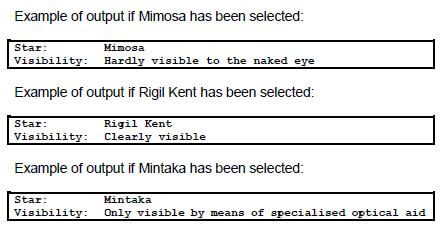 (3)
(3)
- Ensure that your examination number has been entered as a comment in the first line of the object class and the form class.
- Save your program.
- Print the code of both the object class and form class, if required.
TOTAL SECTION B: 56
SECTION C
QUESTION 3: PROBLEM-SOLVING PROGRAMMING
SCENARIO |
Do the following:
- Open the incomplete program in the Question 3 folder.
- Enter your examination number as a comment in the first line of the Question3_U.pas file.
- Compile and execute the program. Currently the program has no functionality.
Supplied GUI:
The GUI below represents the interface of the program. 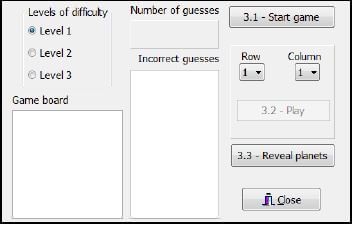
- Complete the code for each question, as described in QUESTION 3.1 to QUESTION 3.3.
NOTE:
- Good programming techniques and modular design must be applied in the design and coding of your solution.
- You may NOT change the code provided.
Supplied code:
The program contains the following code for the declaration of a two-dimensional array called arrGame:
arrGame: array [1..9, 1..9] of char;
The program must do the following:
- Populate the two-dimensional array when the game starts
- Allow the user to guess the positions of invisible planets placed randomly on the game board
- Determine whether the player has won or lost and terminate the game. The player wins when he/she identifies two planets on the game board within five guesses.
3.1 Button [3.1 – Start game]
A dash character (-) represents an open space in the two-dimensional array arrGame and a hash character (#) represents a planet.
The two-dimensional array must first be populated with open-space characters. Its content must be displayed in the game board area.
The level of difficulty selected from the radio group rgbQ3 determines the number of planets to be placed randomly in arrGame. The following applies:
Difficulty level 1: 50 positions in the array must be replaced by planets (#)
Difficulty level 2: 40 positions in the array must be replaced by planets (#)
Difficulty level 3: 30 positions in the array must be replaced by planets (#)
The value '0' must be displayed on panel pnlQ3NumberOfGuesses, which indicates the total number of guesses.
The 'Play' button must be enabled and the rich edit components cleared.
NOTE: The positions of the planets on the game board should NOT be visible (not displayed) to the player.
Example of output when the Start game button is clicked: 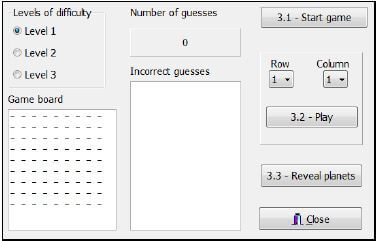 (22)
(22)
3.2 Button [3.2 – Play]
The player must guess the position of a planet by selecting a row number and a column number from the combo boxes provided. Then click the 'Play' button to see whether the position of a planet was guessed correctly.
If the position of a planet is guessed correctly:
- Update the display to show the position of the planet (#) that was guessed correctly.
- Update the number of correct guesses on the panel pnlQ3NumberOfGuesses.
HINT: Replace the planet character (#) that was guessed correctly with another character to show which planets were identified during the game play session. This information is required for Button 3.3 ('Reveal planets').
If the position guessed is NOT the position of a planet:
- Display the row and column values of the incorrect guess in the redQ3Incorrect output area.
The player must be able to guess the positions of planets repeatedly until he/she wins or loses the game.
NOTE: A game is won as soon as the positions of two planets are correctly guessed within the allowed five guesses.
Use a message box to display a suitable message based on the outcome of the game, either 'Game won' or 'Game lost'.
Disable the play button when the game is over.
Example of output if the positions of two planets were guessed correctly within two guesses:
Example of output if the player lost the game. The position of only one planet was guessed correctly within five guesses: 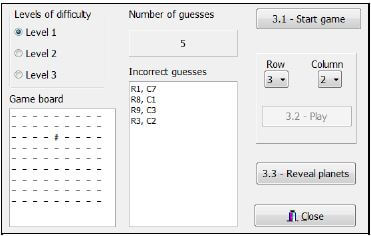 (13)
(13)
3.3 Button [3.3 – Reveal planets]
Write code to display the game board with all the randomly placed planets revealed.
Example of the output if the planets were randomly placed but the player has not played yet: 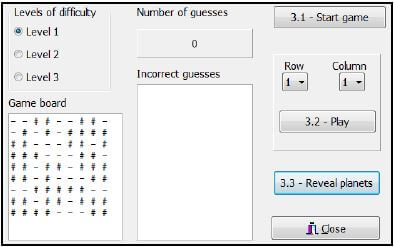
Example of output if the player won by identifying the positions of two planets within two guesses: 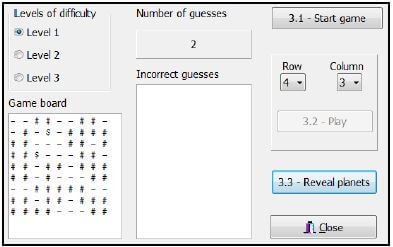
NOTE: The array in the sample output may be different because the indices for the planet symbols are randomly generated. (5)
|
TOTAL SECTION D: 40
GRAND TOTAL: 150